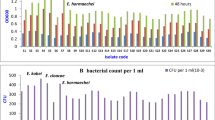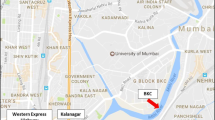Abstract
Twelve isolates of E. coli were isolated from wastewater of El-Malah canal located in Assiut, Egypt and were checked for their heavy metal tolerance. One isolate has tested for its multiple metal resistances and found to be plasmid mediated with molecular weights 27 and 65 kb for hexa- and trivalent chromium. It was identified as E. coli ASU 7. Its minimal inhibitory concentration (MIC) for Cu2+, Co2+, Ni2+, Zn2+, Cr6+, Cr3+, Cd2+ and Pb2+ were 1.57, 2.55, 1.7, 9.17, 0.48, 7.69, 4.4 and 3.1 mM, respectively. Growth kinetics was determined under Cr6+ and Cr3+ stress. SDS-PAGE of protein profile shows that 10 ppm (0.19 mM) of Cr6+ induces new protein with molecular weight 23 kDa.



Similar content being viewed by others
References
Babich H, Stotzky G (1977) Sensitivity of various bacteria, including actinomycetes, and fungi to cadmium and the influence of pH on sensitivity. Appl Environ Microbiol 33:681–695
Baur AW, Kirby WMM, Sherris JC, Turck M (1966) Antibiotic susceptibility testing by a standardized single disc diffusion method. Am J Clin Pathol 45:493–496
Bergey’s Manual of Systematic Bacteriology (2005) Volume two: the proteobacteria part C. Springer Verlag, New York
Bezverbnaya IP, Buzoleva LS, Khristoforova NS (2005) Metal-resistant heterotrophic bacteria in coastal waters of primorye. Russ J Mar Biol 31:73–77. doi:10.1007/s11179-005-0047-0
Bhinde JV, Dhakephalkar PK, Paknikar KM (1996) Microbiological process for the removal of Cr(VI) from chromate bearing cooling tower effluent. Biotechnol Lett 18:667–672. doi:10.1007/BF00130763
Birnboimm HC, Doly J (1979) A rapid alkaline extraction procedure for screening recombinant plasmid DNA. Nucleic Acids Res 7:1513–1523. doi:10.1093/nar/7.6.1513
Bishop PL (2002) Pollution prevention: fundamentals and practice. Beijing Tsinghua University Press
Bruins MR, Kapil S, Oehme FW (2000) Microbial resistance to metals in the environment. Ecotoxicol Environ Saf 45:198–207. doi:10.1006/eesa.1999.1860
Cervantes C, Campos-Garcia J, Devars S, Gutierrez-Corona F, Loza-Tavera H, Torres-Guzman JC, Moreno-Sanchez R (2001) Interactions of chromium with microorganisms and plants. FEMS Microbiol Rev 25:335–47. doi:10.1111/j.1574-6976.2001.tb00581.x
Dhakephalker PK, Chopade BA (1994) High levels of multiple metal resistances and its correlation to antibiotics resistance in environmental isolates of Acinetobacter. Biometals 7:67–74
Ehrlich HL (1997) Microbes and metals. Appl Microbiol Biotechnol 48:687–692. doi:10.1007/s002530051116
Elith M, Garwood S (2001) Investigation into the levels of heavy metals within the manly dam catchment. In: Freshwater ecology report. Department of Environmental Sciences University of Technology, Sydney
Filali BK, Taoufik J, Zeroual Y, Dzairi FZ, Talbi M, Blaghen M (2000) Wastewater bacterial isolates resistant to heavy metals and antibiotics. Curr Microbiol 41:151–156
Ganguli A, Tripathi AK (2002) Bioremediation of toxic chromium from electroplating effluent by chromate reducing Pseudomonas aeruginosa A2Chr in two bioreactors. Appl Microbiol Biotechnol 58:416–420. doi:10.1007/s002530100822
Ghosh S, Mahapatra NR, Banerjee PC (1997) Metal resistance in Acidocella strains and plasmid-mediated transfer of this characteristic to Acidiphilium multivorum and Escherichia coli. Appl Environ Microbiol 11:4523–4527
Hassen A, Saidi N, Cherif M, Boudabous A (1998) Resistance of environmental bacteria to heavy metals. Bioresour Technol 64:7–15. doi:10.1016/S0960-8524(97)00161-2
Hughes MN, Poole RK (1989) Metals and micro-organism. Chapman and Hall, London
Hussein H, Farag S, Kandil K, Moawad H (2005) Resistance and uptake of heavy metals by Pseudomonads. Process Biochem 40:955–961. doi:10.1016/j.procbio.2004.04.001
Laemmli VK (1970) Cleavage of structural proteins during assembly of the head of bacteriophage T4. Nature 277:680–685. doi:10.1038/227680a0
Ledrich ML, Stemmler S, Gilly PL, Foucaud L, Falla J (2005) Precipitation of silver-thiosulfate complex and immobilization of silver by Cupriavidus metallidurans CH34. BioMetals 18:643–650. doi:10.1007/s10534-005-3858-8
Liu GY, Xu WH, Zeng MG, Li X, Gao H (2006) Cr(VI) reduction by Bacillus sp. isolated from chromium landfill. Process Biochem 41:1981–1986. doi:10.1016/j.procbio.2006.04.020
MacFaddin J (1985) Media for isolation-cultivation-identification-maintenance of medical bacteria, vol 1. Williams and Wilkins, Baltimore, Maryland
Mergeay M (1995) Heavy metal resistance in microbial ecosystems. Mol Microb Ecol Man 6:7–17
Nies DH (1999) Microbial heavy-metal resistance. Appl Microbiol Biotechnol 51:730–750. doi:10.1007/s002530051457
Nies DH (2003) Efflux-mediated heavy metal resistance in prokaryotes. FEMS Microbiol Rev 27:313–339. doi:10.1016/S0168-6445(03)00048-2
Pal A, Choudhuri P, Dutta S, Mukherjee PK, Paul AK (2004) Isolation and characterization of nickel-resistant microflora from serpentine soils of Andaman. World J Microbiol Biotechnol 20:881–886. doi:10.1007/s11274-004-2776-1
Patel JS, Patel PC Kalia K (2006) Isolation and characterization of nickel uptake by nickel resistant bacterial isolate (NiRBI). Biomed Environ Sci 19:297–301
Piotrowska-Seget Z, Cycon M, Kozdroj J (2005) Metal-tolerant bacteria occurring in heavily polluted soil and mine spoil. Appl Soil Ecol 28:237–246. doi:10.1016/j.apsoil.2004.08.001
Poole RK, Gadd GM (1989) Metals: microbe interactions. Programme on chemical safety (concise international chemical assessment document 12). IRL Press, Oxford, p 137
Ramteke PW (1997) Plasmid mediated co-transfer of antibiotic resistance and heavy metal resistance in coliforms, Indian J Med Microbiol 37:177–181
Rossbach S, Kukuk ML, Wilson TL, Feng SF, Pearson MM, Fisher MA (2000) Cadmium-regulated gene fusions in Pseudomonas fluorescens. Environ Microbiol 2:373–382. doi:10.1046/j.1462-2920.2000.00117.x
Sabry SA, Ghozlan HA, Abou-zeid DM (1997) Metal resistance and antibiotic resistance patterns of bacterial population isolated from sea water. J Appl Microbiol 82:245–252
Sambrook J, Fritsch EF, Maniatis T (1989) Molecular cloning: a laboratory manual. Cold Spring Harbor Laboratory Press, New York
Sharma R, Rensing C, Rosen BP, Mitra B (2000) The ATP hydrolytic activity of purified ZntA, a Pb(II),Cd(II), Zn(II)-translocating ATPase from Escherichia coli. J Biol Chem 275:3873–3878. doi:10.1074/jbc.275.6.3873
Soltan EM (2001) Isolation and characterization of antibiotic and heavy metal resistant Pseudomonas aeruginosa from different polluted waters in Sohag district, Egypt. J Microbiol Biotechnol 11:50–553
Spain A, (2003) Implications of microbial heavy metal resistance in the environment. Review of Undergraduate Research 2:1–6
Thacker U, Parikh R, Shouche Y, Madamwar D (2007) Reduction of chromate by cell-free extract of Brucella sp. Isolated from Cr(VI) contaminated sites. Bioresour Technolol 98:1541–1547. doi:10.1016/j.biortech.2006.06.011
Ünaldi MN, Korkmaz H, Arikan B, Coral G (2003) Plasmid-encoded heavy metal resistance in Pseudomonas sp. Bull Environ Contam Toxicol 71:1145–1150. doi:10.1007/s00128-003-8575-9
Volesky B (1990) Biosorption and biosorbents. In: Volesky B (ed) Biosorption of heavy metals. CRC press, Florida, pp 3–5
Washington JA, Sutter VL (1981) Dilution test procedures. In: Lennette EH, Balows A, Hausler WJ, Truant JP (eds) Manual of clinical microbiology. American society for microbiology, Washington, District of Columbia, pp 549–555
WHO (World Health Organization) (2005) Guidelines for drinking-water quality, vol 1. WHO, Geneva
Wuertz S, Mergeay M (1997) The impact of heavy metals on soil microbial communities and their activities. In: van Elsas JD, Trevors JT, Wellington EMH (eds) Modern soil microbiology. Marcel Dekker, New York
Yilmaz EI (2003) Metal resistance and biosorption capacity of Bacillus circulans strain EB1. Res Microbiol 154:409–415. doi:10.1016/S0923-2508(03)00116-5
Author information
Authors and Affiliations
Corresponding author
Rights and permissions
About this article
Cite this article
Abskharon, R.N.N., Hassan, S.H.A., Gad El-Rab, S.M.F. et al. Heavy Metal Resistant of E. coli Isolated from Wastewater Sites in Assiut City, Egypt. Bull Environ Contam Toxicol 81, 309–315 (2008). https://doi.org/10.1007/s00128-008-9494-6
Received:
Accepted:
Published:
Issue Date:
DOI: https://doi.org/10.1007/s00128-008-9494-6




